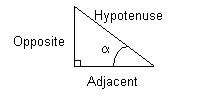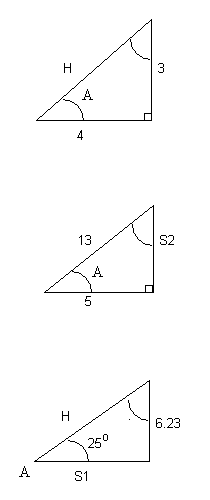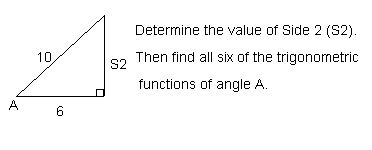Right Triangles
This section is intended as review for some of you and an introduction to angles for those of you who never had trigonometry.
 The window to the right displays a right triangle. Some triangles contain a right angle while others do not. This section will focus on those that contain a right angle. The other types of triangles will be covered later in this course. With right triangles we will introduce several useful definitions.
The window to the right displays a right triangle. Some triangles contain a right angle while others do not. This section will focus on those that contain a right angle. The other types of triangles will be covered later in this course. With right triangles we will introduce several useful definitions.
Trigonometric Definitions
- Hypotenuse of a right triangle is the longest side and it is opposite the right angle in the triangle.
- The Pythagorean formula is applicable: Hypotenuse2 = Side12 + Side22.
- Sine(angle) , abbreviated sin(angle), defined as the side opposite the angle divided by the hypotenuse of the right triangle
- Cosine(angle), abbreviated cos(angle), defined as the side adjacent to the angle divided by the hypotenuse of the right triangle.
- Tangent(angle), abbreviated tan(angle), defined as the side opposite the angle divided by the side adjacent to the angle.
- Cosecant(angle), abbreviated as csc(angle), reciprocal of the sine so it is hyoptenuse divided by side opposite the angle.
- Secant(angle), abbreviated as sec(angle), reciprocal of the cosine so it is hypotenuse divided by side adjacent to the angle.
- Cotangent(angle), abbreviated as cot(angle), reciprocal of the tangent so it is adjacent side divided by side opposite the angle.
When you talk about "solving" a right triangle you mean finding the values of all of the angles and the lengths of all of the sides. Using trigonometry you can solve a right triangle if you are given:
- Any two sides
- Any side and either of the acute angles.
Note you cannot solve a right triangle if you are only given angles. Angles tell you about the shape, but not the size of a right triangle. You need additional information to determine the size of the triangle. The length of any side furnishes that information.
 Let's look at the three triangles shown to the right and determine the values of Sin(A), Cos(A) and Tan(A).
Let's look at the three triangles shown to the right and determine the values of Sin(A), Cos(A) and Tan(A).
- In the first case we know the lengths of two sides. Using the Pythagorean Formula we can find the length of the third side.
- H2 = 42 + 32, H2 = 16 + 9 = 25, H = Sqrt(25) = 5
- Sin(A) = 3/5, Cos(A) = 4/5 and Tan(A) = 3/4
- In the next case we know the hypotenuse and one side but need the value of the other side.
We will use the Pythagorean Formula again but with a slight variation. This time we are looking for the value of a side not the hypotenuse. So we will write it as:
- Side2 = 132 - 52
- Side2 = 169 - 25 = 144
- Side = Sqrt(144) = 12
- Sin(A) = 12/13, Cos(A) = 5/13 and Tan(A) = 13/5
- For the last case we again know the one angle and one side. In the first two cases we used the Pythagorean Theorem to determine the lengths of the sides of the triangle and the values of the trigonometric funcitons. In this case we will use the definitions of the trigonometric funcitons, along with the calculator values of the trigonometric functions to determine the lengths of the hypotenuse and the one unknow side of the triangle.
- sin(25o) = 6.23/H, H = 6.23/sin(25o) = 14.74
- cos(25o) = S1/14.74, S1 = 14.74 * cos(25o) = 13.36
Now it is your turn to try it. Here is a sample problem - Problem 1. The answer is at the end of this page.

Now let's look at a slightly different problem. What if you have the trigonometric functions but want to find the angles? To solve this problem we will need to introduce the idea of the INVERSE FUNCTION. On your calculator there are probably three buttons labled with trigonometric buttons. They probably look something like this:
 The window to the right displays a right triangle. Some triangles contain a right angle while others do not. This section will focus on those that contain a right angle. The other types of triangles will be covered later in this course. With right triangles we will introduce several useful definitions.
The window to the right displays a right triangle. Some triangles contain a right angle while others do not. This section will focus on those that contain a right angle. The other types of triangles will be covered later in this course. With right triangles we will introduce several useful definitions.
 Let's look at the three triangles shown to the right and determine the values of Sin(A), Cos(A) and Tan(A).
Let's look at the three triangles shown to the right and determine the values of Sin(A), Cos(A) and Tan(A).
